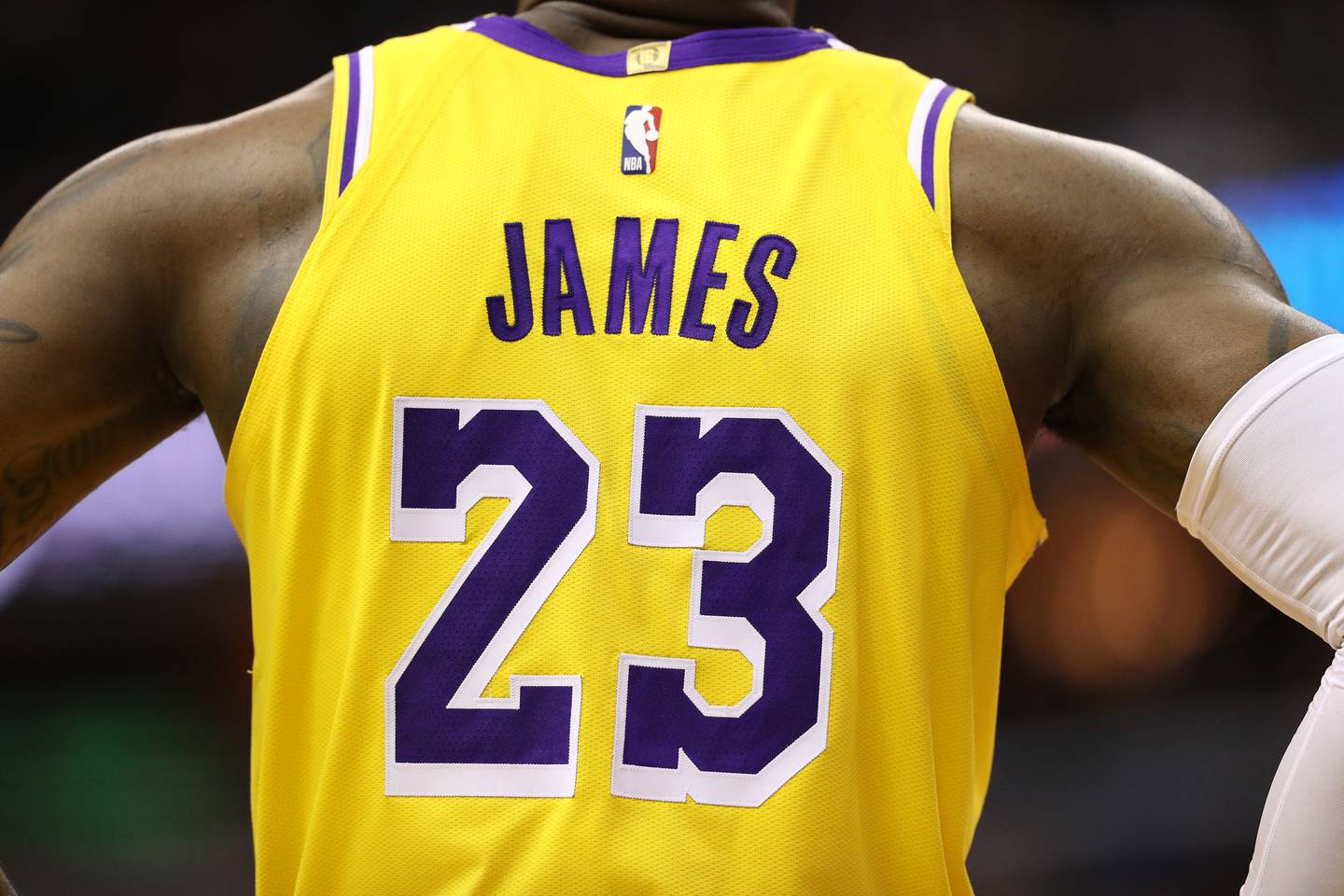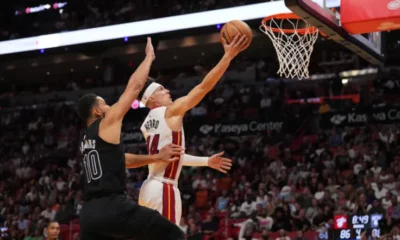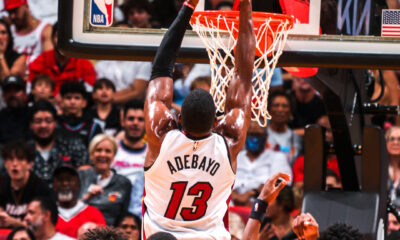Sports
The “GOAT” Case for LeBron James Part I: The Embellishment of the 90s
Published
1 year agoon
By
Roland Gomez
Lebron James is the NBA’s all-time leading scorer after breaking Kareem’s 39-year-old scoring record. In light of this accomplishment, this author will take a look at Lebron’s career, his body of work, his accomplishments, and failures, and make the case for why he is the greatest player of all time through a series of weekly articles.
The case for who the greatest basketball player of all time seems to be a never-ending debate. From shows like First Take or Undisputed to playgrounds and schools all over the United States, the debate between Michael Jordan, Lebron James, and to a lesser extent Kobe Bryant rages on. As Lebron James enters the last third of his career, he has surpassed the NBA’s all-time leading scorer Kareem -Abdul Jabbar, who scored a record 38,387 points in his career. The record stood for 39 years. As Lebron is now in possession of this hallowed record, we will examine different aspects and perspectives of his career prowess. Subsequent articles will focus specifically on championships, clutch factor, scoring, defense, and different aspects of his game. But one of the knocks against Lebron James is that he didn’t need to play in the tough 90s decade in which Jordan played and dominated. This is why today I want to dispel the myth of the 90s as an uber-talented decade.
The first thing talked about is how tough it was to score in the 90s. A decade when the Bad Boy Pistons and the New York Knicks were specially made famous for their defensive brand of rough-and-tumble basketball. A lot of critics have looked at today’s NBA and critiqued the rule changes that go on today to make the game softer than in the 1990s era. I argue that the modern NBA game today is in many ways harder than in the 1990s.
While I will concede that the 90s was a more physical era, the level of athleticism and physicality of players has increased significantly, making it harder for players to score and defend. This can be seen especially with the wing players. In the 90s for example, Jordan was peerless in terms of athleticism. Even the best wing players in the late 80s and 90s such as Joe Dumars, Isaiah Thomas, Grant Hill, and Clyde Drexler, Gary Payton although very skilled, were not at Jordan’s level in terms of athleticism. When we take a look at the modern wings that Lebron James had to play against and guard in their primes such as Kawhi Leonard, Kevin Durant, Kobe Bryant, Tracy McGrady, Giannis Antetokounmpo, Dwyane Wade, Steph Curry, Derrick Rose, just to name a few, provided a combination of athleticism, size, and shooting at the wing and guard position that was vastly superior to the wings and guards in the 90s. Jordan for example primarily guarded less athletic guards, while Scottie Pippen guarded bigger wings or larger guards like Magic Johnson in the 1991 finals.
Another point that is often ignored is that Lebron James weighs more than anyone on the Dream Team. Imagine a 6’9′ physical freak with speed like a guard with a 44-inch vertical leap, that outweighs Ewing by 20 lbs., and Larry Bird by 40 lbs. Imagine someone of Lebron’s size using hand checking. Let us not forget that during this era, the NBA actually made the game easier by shortening the three-point line, making it easier to score. Or the fact that from 1988-1996 there were SIX expansion teams that came to the NBA and diluted the NBA talent pool.
The modern NBA also has an international pool of players that is vastly deeper than what the ’90s era had to offer. The “Lebron” Era for example saw international stars such as Manu Ginobili, Tony Parker, Dirk Nowitzki, Giannis Antentokounmpo, Luka Doncic, Nikola Jokic, Yao Ming, Pau Gasol, Steve Nash, and Joel Embiid as Hall of Fame caliber players. When compared to the 90s, the international game paled in comparison. Hakeem Olajuwon, one of the best centers of all time is the one true superstar hall of famer that would fit the talent level of the above list. Rik Smits, Drazen Petrovic, Arvydas Sabonis, Vlade Divac, Dikembe Mutombo, Detlef Schrempf, Toni Kukoc are the notable international standouts of the 90s and their accomplishments and talent pale in comparison to international players in the modern era.
If we tally the number of All-Star appearances, All-NBA selections, and MVP awards the international players in the 90s had a combined: 26 All-Star appearances, 11 All-NBA selections, and 1 MVP. How much deeper is the international game today? Considering many of the international players are just entering their prime and still have at least half of their careers left, the contrast in talent level is astonishing. International Players mentioned above, during the Lebron Era so far, have 62 All-Star Selections, 53 All-NBA selections, and have earned 7 MVP awards. The scary part? I only chose the best of the very best (surefire hall of fame international players). The international pool is so deep in the Lebron era that I left out quality players such as Al Horford, Joakim Noah, Marc Gasol, Rudy Gobert, Peja Stojokavic, Karl Anthony- Towns, Ben Simmons, Goran Dragic, Luol Deng, Zydrunas Ilgauskas and dozens of others. The talent pool in the modern game internationally blows the 90s decade out of the water.
The game today has become more fast-paced and up-tempo, which can be difficult to keep up with, especially for big men. The 90s was known as a center-dominated league with big men mostly living inside the paint. Today’s game makes it very hard for traditional centers to flourish, as they are seen more as a liability, because of their inability to run the floor and the switching that occurs in the modern game that has centers guarding wings/guards by the 3-point line. Roy Hibbert for example was one of the most effective defensive centers and then all of a sudden became unplayable as the rules made it hard for him to operate.
In the 1990s, zone defenses were not as common in the NBA and teams relied mostly on man-to-man defense. However, with the evolution of the game and the advancements in coaching, zone defenses have become more prevalent in the league and teams have had to adapt to this new challenge. Zone defenses can make it harder for teams to score because they force players to take less efficient shots, such as 3-pointers or shots from the outside. Zone defenses slow down the pace of the game and make it harder for teams to run fast breaks and get easy baskets. In a zone defense, for example, players don’t have to fully commit to a double, they can rover and commit late. In the 90s, which focused more on man-to-man defense, a player could not rover, you had to fully commit to a double team without spying. Imagine then how many assists Lebron James would have had in the 90s just knowing that it was an illegal defense for someone to rover?
The 1990s was a physical decade and I believe that many of the great players in that era would be all-star caliber players in this era as well. Yet, I find the idea that Lebron James would somehow struggle in that era ludicrous when less skilled guys like Karl Malone, and Charles Barkley had tremendous success. Even against Ben Wallace and the bad boy Pistons, a young, green Lebron James found success despite the fact that the rules were very similar in the late 90s in terms of physicality. Furthermore, if you insert Lebron in the 1994 Bulls team that won 55 games without Michael Jordan, it is a foregone conclusion that the Bulls team would have run away with the championship (Pete Myers, Jordan’s replacement averaged just 7.9 points per game that season). For the above reasons, we should stop embellishing the 90s as the “golden age” of basketball. The game continues to evolve, and in some ways, it has become harder and of higher quality than before.
You may like
-


Heat Drop Fourth Consecutive Game, Off to Their Worst Start in Over 15 Years
-


Thoughts and Impressions from the Miami Heat’s Season Opening Victory over the Detroit Pistons
-


Sports Giants Seek to Rewrite DMCA Laws to Combat Illegal Livestreams
-


OPINION: Navigating the James Harden Conundrum – A Tale of Misguided Ambitions and Fading Stardom?
-


The MSG Sphere in Las Vegas: A Glimpse into the Future of Sports and Entertainment
-


NBA Cup: Inaugural In-Season Tournament Coming in November
Legal


NCAA Intends to Enhance Consumer Protection in Ever-Changing NIL Era
Charlie Baker, the president of the NCAA, has expressed the urgent need to establish a “consumer protection system” tailored for...


Redefining the Game: How One Attorney’s Fight Could Revolutionize College Athletes’ Rights
John “Jake” Krupski, a seasoned labor attorney from New Hampshire, was well-versed in representing the rights of various workers, including...


Clemson Files Lawsuit Over ACC Grant of Rights, Looking for Exit Out of Conference
In a bold move that reverberates across the collegiate sports landscape, Clemson University has taken the Atlantic Coast Conference (ACC)...


The Enhanced Games: A Controversial Pro-PEDs Take on the Olympics
In a daring departure from conventional sports norms, billionaire entrepreneur Peter Thiel, co-founder of PayPal and Palantir, is making waves...


Lawsuit Against Mars Inc. Claims Dark Chocolate Contains Toxic Metals
A proposed class action lawsuit has been filed in New York federal court claiming Mars Inc. failed to warn consumers...


CPAP Machines and Mechanical Ventilators Recalled Over Issues with Foam
LEARN MORE CASE UPDATE: On January 29, 2023, Philips Respironics announced it would halt sales of all its breathing machines in...

